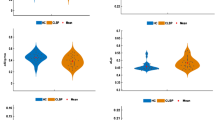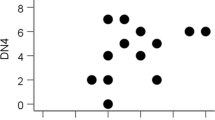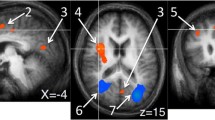Abstract
Purpose
Chronic low back pain (CLBP) is one of the most important pain disorders with increasing social and economic implications. Given that CLBP is a multidimensional process associated with comorbidities such as anxiety and depression, treatment of chronic low back pain is still a challenge. Advancement of in vivo brain imaging technologies has revealed increasing insights into the etiology and pathogenesis of chronic pain; however, the exact mechanisms of chronification of LBP remain still unclear. The purpose of the present study was to analyse the neurostructural alterations in CLBP and to evaluate the role of comorbidities and their neurostructural underpinnings.
Methods
In the present study we investigated a well-characterized group of 14 patients with CLBP and 14 healthy controls applying structural MRI and psychometric measures. Using an improved algorithm for brain normalization (DARTEL) we performed a voxel-based morphometry (VBM) approach. Correlation analyses were performed to evaluate the role of anxiety and depression in neurostructural alterations observed in CLBP.
Results
The psychometric measures revealed significantly higher scores on depression and anxiety in the patient population. VBM analysis showed significant decreases in grey matter density in areas associated with pain processing and modulation, i.e. the dorsolateral prefrontal cortex, the thalamus and the middle cingulate cortex. With respect to anxiety and depression scores, we did not observe any correlations to the structural data.
Conclusions
In the present study we found compelling evidence for alterations of grey matter architecture in CLBP in brain regions playing a major role in pain modulation and control. Our results fit the hypothesis of a “brain signature” in chronic pain conditions. The results of the psychometric assessment underline the importance of an interdisciplinary therapeutic approach including orthopedic, neurological and psychological evaluation and treatment.

Similar content being viewed by others
References
Merskey H (1979) Pain terms: a list with definitions and a note on usage. Recommended by the International Association for the study of Pain (IASP) Subcommittee on Taxonomy. Pain 6:249–252
Krismer M, van Tulder M (2007) Strategies for prevention and management of musculoskeletal conditions. Low back pain (non-specific). Best Practice & Research Clinical Rheumatology 21:77–91
Deyo RA, Weinstein JN (2001) Low back pain. N Engl J Med 344:363–370
Hashemi L, Webster BS, Clancy EA (1998) Trends in disability duration and cost of worker`s compensation low back pain claims (1988–1996). Journal Occup Environ Med 40:1110–1119
Schneider S, Lipinski S, Schiltenwolf M (2006) Occupation associated with a high risk of self-reported back pain: representative outcomes of a back pain prevalence study in the Federal Republic of Germany. Eur Spine J 15:821–833
Wand BM, Parkitny L, O´Connell NE, Luomajoki H, McAuley JH, Thacker M, Moseley GL (2011) Cortical changes in chronic low back pain: current state of the art and implications for clinical practice. Manual Therapy 16:15–20
Tracey I, Bushnell MC (2009) How neuroimaging studies have challenged us to rethink: is chronic pain a disease? The Journal of Pain 10:1113–1120
Borsook D, Moulton EA, Schmidt KF, Becerra LR (2007) Neuroimaging revolutionizes therapeutic approaches to chronic pain. Molecular Pain 3:25
Grachev ID, Fredrickson BE, Apkarian VA (2000) Abnormal brain chemistry in chronic back pain: an in vivo proton magnetic resonance spectroscopy study. Pain 89:7–18
Apkarian AV, Sosa Y, Sonty S, Levy RM, Harden RN, Parrish TB, Gitelman DR (2004) Chronic back pain is associated with decreased prefrontal and thalamic ray matter density. J Neurosci 24:10410–10415
Schmidt-Wilcke T, Leinisch E, Gänßbauer S, Draganski B, Bogdahn U, Altmeppen J, May A (2006) Affective components and intensity of pain correlate with structural differences in gray matter in chronic back pain patients. Pain 125:89–97
Buckalew N, Haut MW, Morrow L, Weiner D (2008) Chronic pain is associated with brain volume loss in older adults: preliminary evidence. Pain Medicine 9:240–248
Merskey H, Bogduk N (eds) (1994) Classification of Chronic Pain. IASP Press, Descriptions of Chronic Pain Syndromes and Definitions of Pain Terms. Second Edition
Geissner E (1995) (1995) The Pain Perception Scale – a differentiated and change-sensitive scale for assessing chronic and acute pain. Rehabilitation (Stuttg.) 34:35–43
Mannion AF, Junge A, Fairbank JCT, Dvorak J, Grob D (2006) Development of a German version of the Oswestry Disability Index. Part 1: cross-cultural adaptation, reliability, and validity. Eur Spine J 15:55–65
Borkenau P, Ostendorf F (2008) NEO-Fünf-Faktoren-Inventar nach Costa und McCrae. Hogrefe, Göttingen
Goldberg LR (1990) An alternative “description of personality”: the big-five factor structure. J Pers Soc Psychol 59:1216–1229
Beck AT, Steer RA, Brown GK (1996) Beck Depression Inventory - Second Edition. The Psychological Corporation, San Antonio, Manual
Beck AT, Steer RA (1993) Beck Anxiety Inventory. The Psychological Corporation, San Antonio, Manual
Maldjian JA, Laurienti PJ, Burdette JB, Kraft RA (2003) An Automated Method for Neuroanatomic and Cytoarchitectonic Atlas-based Interrogation of fMRI Data Sets. NeuroImage 19:1233–1239
Yarkoni T, Poldrack RA, Nichols TE, Van Essen DC, Wager TD (2011) Large-scale automated synthesis of human functional neuroimaging data. Nat Methods 8:665–670
Hautzinger M, Keller F, Kuehner C (2009) BDI-II. Beck Depressions-Inventar, Revision. Pearson, Frankfurt
Margraf J, Ehlers A (2007) Beck Angst-Inventar – BAI. Manual, Harcourt, Frankfurt
Chapman CR, Gavrin J (1999) Suffering: the contributions of persistent pain. Lancet 353:2233–2237
Baliki MN, Schnitzler TJ, Bauer WR, Apkarian AV (2011) Brain morphological signatures for chronic pain. PLoS ONE 6(10):e26010
Rusheweyh R, Deppe M, Lohmann H, Stehling C, Flöel A, Ringelstein EB, Knecht S (2011) Pain is assocoiated with regional grey matter reduction in the general population. Pain 152:904–911
Siddall PJ, Stanwell P, Woodhouse A, Somorjai RL, Dolenko B, Nikulin A, Bourne R, Himmelreich U, Lean C, Cousins MJ, Mountford CE (2006) Magnetic resonance spectroscopy detects biochemical changes in the brain associated with chronic low back pain: a preliminary report. Anesth Analg 102:1164–1168
Levy R, Deer TR, Henderson J (2010) Intracranial neurostimulation for pain control: a review. Pain Physician 13:157–165
Lorenz J, Minoshima S, Casey KL (2003) Keeping pain out of the mind: the role of the dorsolateral prefrontal cortex in pain modulation. Brain 126:1079–1091
Wager TD, Rilling JK, Smith EE, Sokolik A, Casey KL, Davidson RJ, Kosslyn SM, Rose RM, Cohen JD (2004) Placebo-induced changes in fMRI in the anticipation and experience of pain. Science 303:1162–1167
Zubieta JK, Bueller JA, Jackson LR, Scott DJ, Xu Y, Koeppe RA et al (2005) Placebo effects mediated by endogenous opiod activity in mu-opiod receptors. J Neurosci 25:7754–7762
Krummenacher P, Candia V, Folkers G, Schedlowski M, Schonbachler G (2010) Prefrontal cortex modulates placebo analgesia. Pain 148:368–374
Seminowicz DA, Davis KD (2006) Cortical responses to pain in healthy individuals depends on pain catastrophizing. Pain 120:297–306
Seminowicz DA, Wideman TH, Naso L, Hatami-Khoroushahi Z, Fallatah S, Ware MA, Jarzem P, Bushnell MC, Shir Y, Ouellet JA, Stone LS (2011) Effective treatment of chronic low back pain in humans reverses abnormal brain anatomy and function. J Neurosci 31:7540–7550
Rodriguez-Raecke R, Niemeier A, Ihle K, Ruether W, May A (2009) Brain gray matter decrease in chronic pain is the consequence and not the cause of pain. J Neurosci 29:13746–13750
Derbyshire SWB, Jones AKB, Devani P et al (1994) Cerebral responses to pain in patients with atypical facial pain measured by positron emission tomography. J Neurol Neurosurg Psychiatry 57:1166–1172
Hsieh JC, Belfrage M, Stone-Elander S, Hansson P, Ingvar M (1995) Central representation of chronic ongoing neuropathic pain studied by positron emission tomography. Pain 63:225–236
Jones AKP (1997) Derbyshire SW (1997) Reduced cortical responses to noxious heat in patients with rheumatoid arthritis. Ann Rheum Dis 56:601–607
Brunelin J, Poulet E, Boeuve C, Zeroug-vial H, d`Amato T, Saoud M (2007) Efficacy of repetitive transcranial magnetic stimulation (rTMS) in major depression: a review. Encephale 33:126–134
Drevets WC, Savitz J, Trimble M (2008) The subgenual anterior cinglate cortex in mood disorders. CNS Spectr 13:663–681
May A (2008) Chronic pain may change the structure of the brain. Pain 137:7–15
Author information
Authors and Affiliations
Corresponding author
Rights and permissions
About this article
Cite this article
Ivo, R., Nicklas, A., Dargel, J. et al. Brain structural and psychometric alterations in chronic low back pain. Eur Spine J 22, 1958–1964 (2013). https://doi.org/10.1007/s00586-013-2692-x
Received:
Accepted:
Published:
Issue Date:
DOI: https://doi.org/10.1007/s00586-013-2692-x




